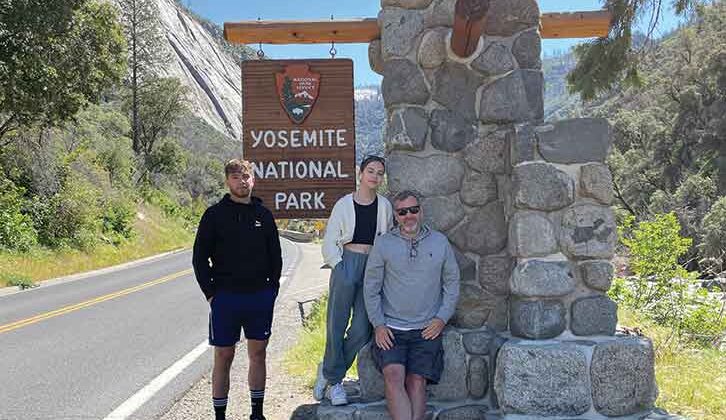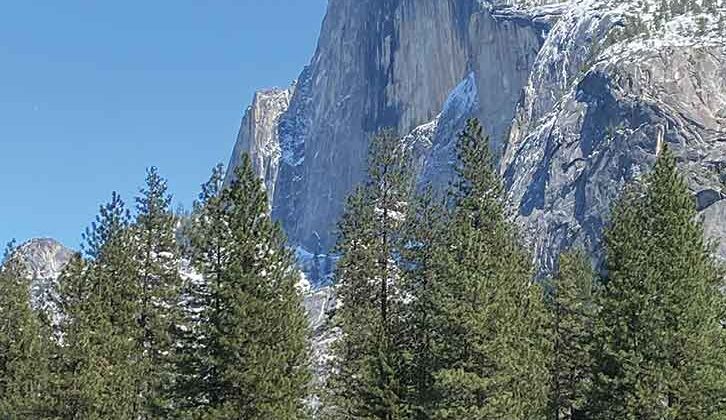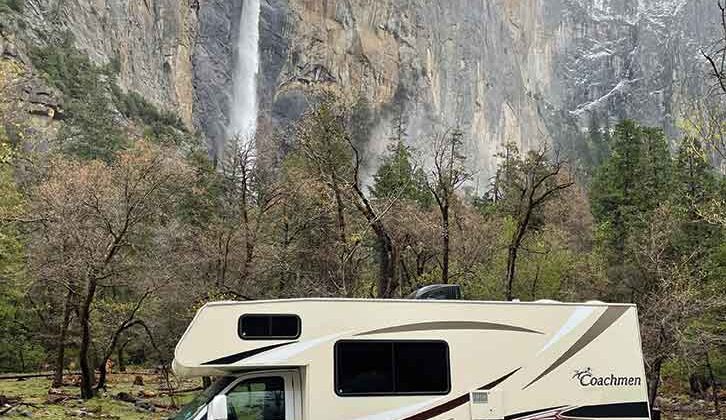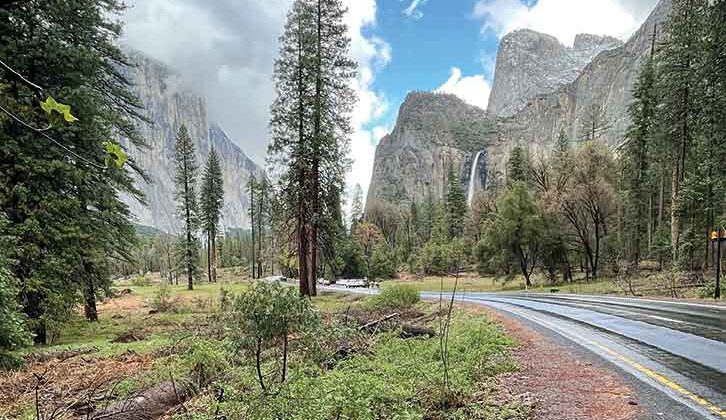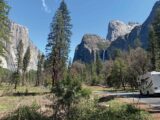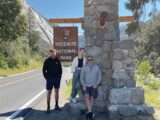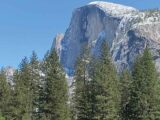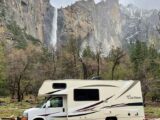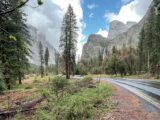There’s the Great Outdoors, and then there’s the mighty Yosemite National Park – a truly breathtaking, neck-craning collection of granite cliffs and peaks, surrounding a valley
with the Merced River meandering through.
Legendary American landscape photographer Ansel Adams is revered for his black and white photographs of this ‘other worldly’ destination, and it’s his pictures that have made me long to visit Yosemite for, oh, about 40 years.
Yosemite became a National Park in 1864, and it covers almost 1200 square miles of dramatic High Sierra terrain. From mountain to meadow, waterfall to wilderness, this region really does have it all, making it perfect for the hardcore hiker or climber, photographers, nature lovers and, yes, your bog-standard tourist.
The National Park covers a large area, but it’s centred on the relatively compact Yosemite Valley, and there’s no better way to immerse yourself in this astonishing part of the world
than by visiting in an RV (and if yours needs a clean, be sure to take a look at our best RV cleaner guide).
Driving into Yosemite National Park
There are three routes into this American Shangri-La. We first drove in from the west, taking Highway 140 past Mariposa (with its restaurants and supermarket) and Midpines (there’s a tiny roadside all-American store and petrol station here, the last before you enter the valley).
This road follows the Merced River as it frolics past giant boulders and rolls over rapids. From time to time, you’ll spot inflatable rafts braving those tumultuous currents.
As you’re funnelled into the valley, the rock faces on each side grow higher and ever more precipitous. The drama builds beautifully!
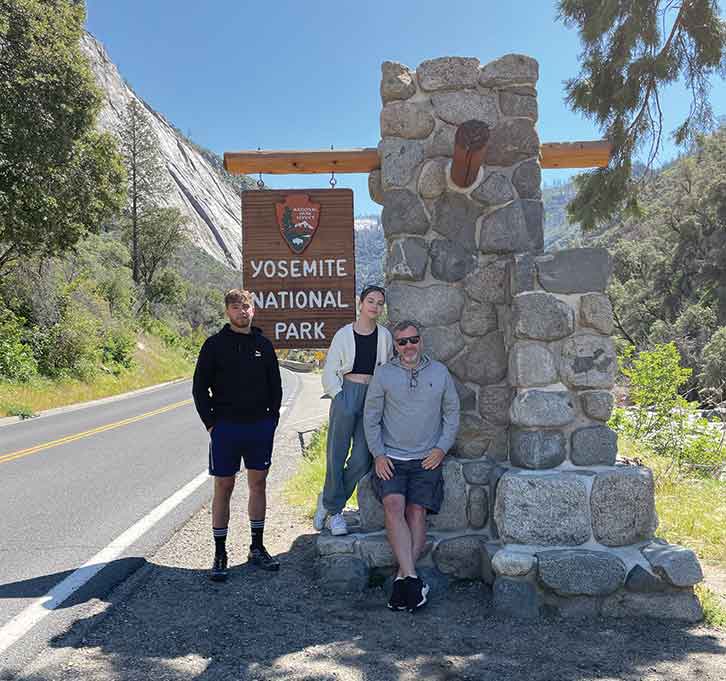
Eventually, you reach a toll-booth, where you will be relieved of $35 (£28). This allows access to the park for a whole week and helps to support the continuing renovation of infrastructure and buildings. On busy days, especially in summer and on national holidays, you will have to queue to get into the park. There’s no doubt it takes some of the shine off the experience, so plan ahead and try to visit out of season, during the week, or enter before 10am or after 3pm.
We got lucky, with relatively little congestion, although it did take a while to get out of the car park in the late afternoon.
Shortly after you pass the pay-booth, there’s an interesting ‘rock gateway’ to drive through, which might test the nerves of those visitors driving bigger vehicles.
In summary, Highway 140 is an easy, largely flat and interesting drive into the park, which takes about an hour from Mariposa.
Highway 120 runs west to east across the park and roughly parallel with the valley. If you come from the east, you’re on Tioga Road, and from the west, Big Oak Flat Road. At the point where they meet, there’s a fuel station and the Crane Flat Campground. Here, turn onto, or stay on, Big Oak Flat Road, and follow it for about 10 miles south as it winds its way up the mountain before dropping down into the valley.
In good weather, this is a very picturesque drive, but in the colder months it’s likely to be either closed or snowbound, requiring snow chains.
The same is also true for Highway 41, Wawona Road, which enters the valley from the opposite side. Again, this road weaves its way up, then down into the valley.
On the descent, you’ll pass through a long tunnel and emerge to what must be one of the finest views in the world – imaginatively titled ‘Tunnel View’!
From this lofty vantage point you’re looking down the tree-lined Yosemite Valley. The famous Bridalveil Fall plunges 620ft off the side of the mountain to the south, while opposite,
El Capitan stands sentinel over the entire valley. This jaw-dropping 3000ft cliff frames the northern side, with the majestic Half Dome in the distance.
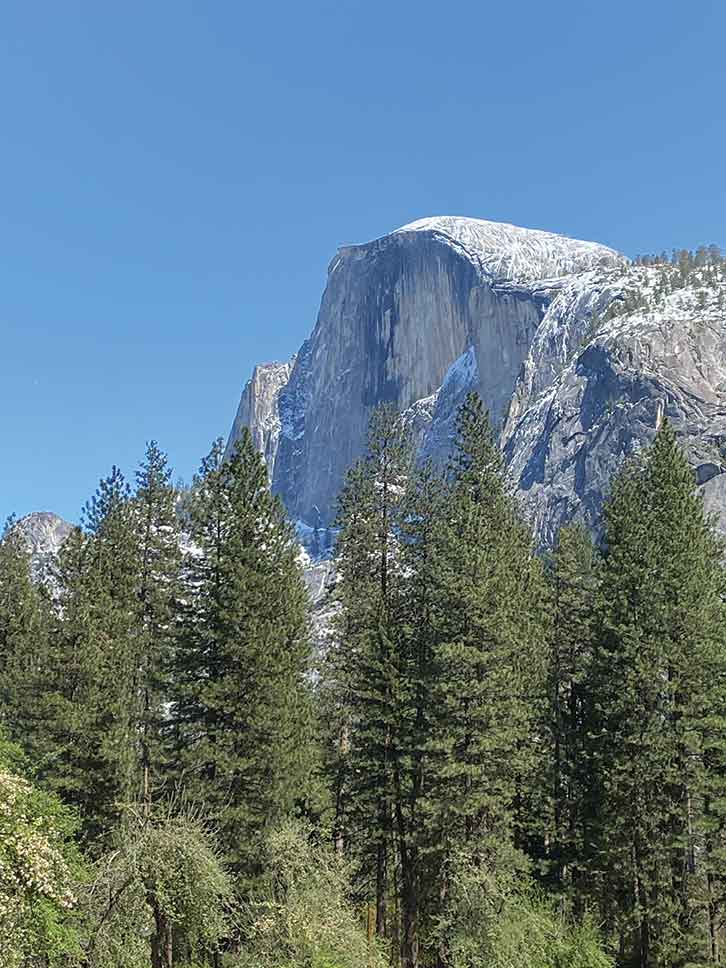
There is perhaps one view even better than this in Yosemite, and that’s the vista to be seen from Glacier Point. The road to this ultimate viewing platform is halfway along the Wawona Road, at Yosemite West. Unfortunately, access is closed in winter, and when we visited, snow chains were understandably de rigueur. But I’ve seen the photographs and that stunning view down onto Half Dome from the elevation of 7214ft is, quite simply, magnificent.
When to visit Yosemite National Park
You can visit Yosemite at any time of the year, although in the winter months – and we’re talking October to May, in this case – you might be limited in terms of which route you can enter the valley by. The higher roads are likely to be blocked by snow.
At either end of this period, as the weather conditions ease, snow chains remain essential. Purchase them before you enter the park, too, because you’ll find yourself paying a chunky premium if you forget to do so.
We visited during the second week in April, just before Easter. This proved to be a fortuitous choice, because the weather was (largely) good and the traffic remained (largely) free-flowing.
Perhaps as a result of its extreme topography, Yosemite Valley seems to have a micro-climate of its own. In just one hour, we had bright sunshine, followed by clouds, then rain and finally, snow! And 10 minutes later, the sun was out again.
If you don’t want to drive, and you are happy to walk or cycle once you are in the valley, leave the RV on site and grab public transport or the Yosemite Shuttle to head into the park.
Where to stay
There is no wild camping in Yosemite, and most campsites that take RVs will require a reservation – sometimes up to five months in advance, so you want to choose the right campsite nice and early.
If you’re happy to sleep outside the park, the National Park Service recommends pitching on a campsite nearby and taking the YARTS (Yosemite Area Regional Transportation System) buses into the park itself. Tickets can be booked online and one child (6-12) goes free with any adult, while children aged 13-17 get reduced fares.
Park entry is included in the tickets, which cost from $14 to $111 for 10 return trips, depending where you travel into the park from.
There are 13 camping grounds in the Yosemite National Park, although most of these are outside the valley itself. Yosemite Valley Campground, at the eastern end of the gorge, is where most of the facilities are located.
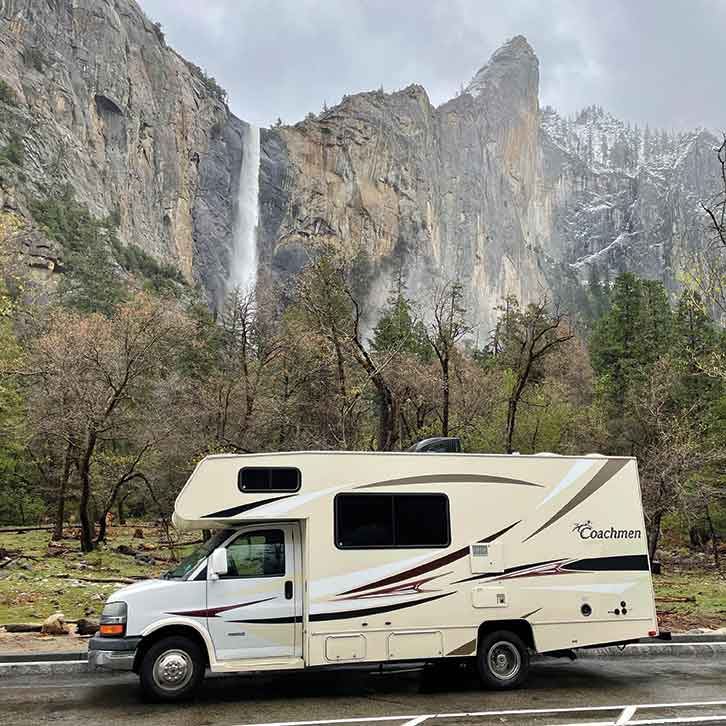
Surprisingly, some camping infrastructure dates back to the 1950s – facilities that haven’t been updated since Eisenhower was in the White House! But a major investment began in 2020, renovating not just roads and visitor centres, but toilet and camping facilities, too. Of course, in an RV, you’re likely to be self-sufficient for washroom facilities.
Housekeeping Camp provides fixed concrete and canvas structures that you can rent (and park nearby), while the Pines Campgrounds (Lower, Upper and North) cater for leisure vehicles.
Lower Pines offers 10 non-electric RV pitches, Upper Pines has 28 and North Pines has 15. Pitch numbers are limited, so book well ahead.
In the greater Yosemite Park, there’s plenty of campsite choice and many have their own trailheads, allowing you to roll out of bed and straight onto a sensational trek. Almost all are seasonal, though, so again, plan ahead.
Facilities
At the eastern end of the valley, there’s a Visitor Centre, (pricey) general store, cycle hire, a chapel, a swimming pool, an ice rink and the Ansel Adams Gallery.
Adams (1902-1984) is best known for shooting and printing sensational, high-contrast images of Yosemite. His pictures, usually shot with a ‘cloth over the head’ plate camera, have become iconic, and he is considered America’s greatest exponent of landscape photography. If you happen to have a spare $10,000-$30,000 kicking around, you could invest in an original print at the gallery. We settled for postcards at $1.25 each!
Given its location and the demand, nothing is cheap in the valley. Plan ahead and stock up on fuel and necessities before you arrive.
What to see
To aid traffic flow, there’s a one-way system in the valley. You head in towards Yosemite Village on Southside Drive, then loop around and drive out on – you guessed it – Northside Drive. There are plenty of places to pull over, even if you’re in an oversized vehicle.
I’d recommend parking at Bridalveil Fall for an hour or so, to take in the majesty of El Capitan and the falls. There is a stunning viewpoint at the Swinging Bridge Picnic Area, where a wooden bridge crosses the Merced River. On a sunny day, you could take advantage of the small beach here and the crystal-clear (although probably freezing) waters of the Merced.
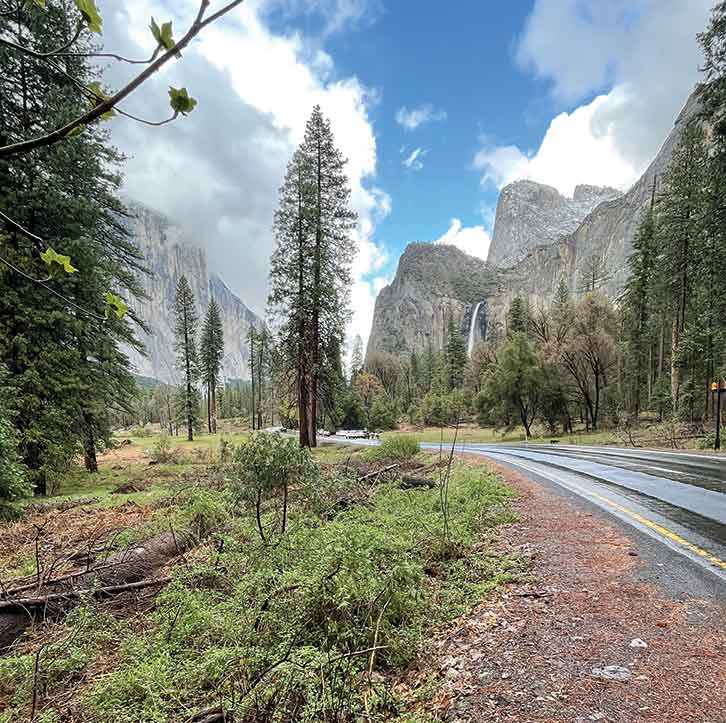
Drive on around the loop and you’ll pass under the towering El Capitan on your left. This sheer granite cliff is a popular challenge for climbers, so try to spot them on the face, to gain a rather jaw-dropping sense of scale.
The formation was first conquered by climbers in 1958 on a 47-day mission. The current record, which was set in 2018, is a flabbergasting one hour, 58 minutes and seven seconds!
Famously, on 3 June 2017, the first free solo climb of El Capitan was completed by Alex Honnold. Climbing on his own, without ropes, he ascended the cliff face in three hours and 56 minutes. His efforts were filmed for the 2018 documentary Free Solo, which is well worth watching before you head out west.
The peak of El Capitan can be hiked (rather than climbed) by following the trail next to Yosemite Falls and proceeding west. The main peak hikes – pretty intense physical challenges – should not be taken lightly. But the sense of achievement when you complete one, and the sensational views, make the effort worthwhile if you can.
A little further on, Sentinel Beach is on your left, a very pleasant spot for a picnic.
As you reach the end of the valley, you’ll see more car parking and campsites. Many hikes are accessible from here, including those where you can see the Half Dome at close quarters.
The easier routes that traverse the valley floor, heading north-east, can be done on foot, on a bicycle or in a wheelchair. The walk to Mirror Lake, for example, is a gentle two-miler, so something of a contrast to the strenuous, but rewarding, 14-mile hike to Half Dome.
Those who are up for a challenge – and even better views – should head south to Vernal Fall and try to conquer the John Muir Trail.
From a point near Nevada Fall, you can loop back and head to that astonishing vista at Glacier Point. High-performance hikers can walk all the way to the summit of Half Dome, although you’ll need a permit for this trek.
The hiking in Yosemite is world-class, and July delivers the perfect combination of trail choice (they’re all open) plus great weather and visibility. Yosemite has more than 800 miles of trails, and they all offer astonishing views. Many also lead to splendid waterfalls, lakes or dramatic peaks.
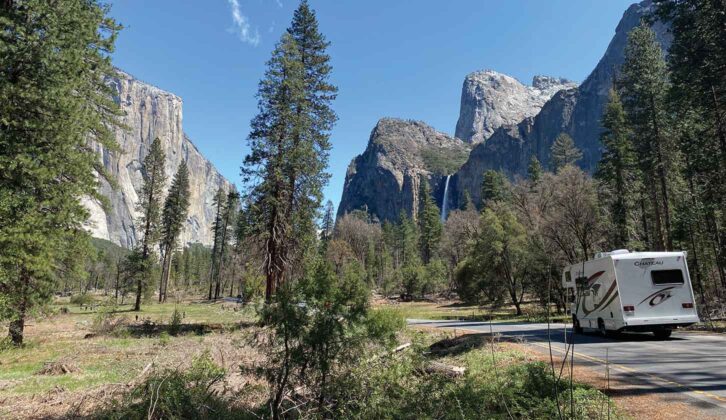
Remember, though, that the weather changes rapidly in Yosemite, so make sure you always go equipped with suitable footwear, wet-weather gear, food and water.
For visitors seeking a more relaxed experience, there’s plenty to fill a day. Take a gentle stroll and visit the various attractions, before enjoying a picnic among these vast peaks, perhaps on the banks of the Merced River.
Yosemite’s landscape provides a multitude of other recreational activities, from biking and fishing to horseriding and rafting, along with cross-country skiing in winter – and superb photography at any time of year.
You can always end your day with a coffee at the Ahwahnee Hotel, named for the indigenous people who originally inhabited the valley, the Ahwahneechee. The hotel is perhaps best known for inspiring the design of the Overlook Hotel in Stanley Kubrick’s masterpiece, The Shining!
Flora and fauna
Yosemite offers much more than just gigantic rock formations. It’s filled with stunning trees and shrubs, from giant sequoias, to California black oak, incense-cedar, white fir, Ponderosa pine and white-leaf manzanita.
Bears are a common sight and are attracted to the smell of food. If you want to keep your RV in one piece, you shouldn’t leave food lying around. Hikers use bear-resistant containers, and many of the bins in the park are also proofed against inquisitive bears. Meanwhile, you also need to keep an eye out for coyotes and rattlesnakes, and take mosquito repellent, too.
Lasting impression
Yosemite was everything I hoped for – vast in scale and fascinating in detail. More interesting than the Grand Canyon and more compact than the Himalayas, there’s just so much to see. I’d recommend two full days, and if you undertake a major hike, add another day. Plan your trip well in advance, so you can take your time to soak up the wonders of this astounding destination.
Looking to embark on a tour a bit closer to home instead? Then take a look at our guide to the best motorhome sites in the UK, where we share the top destinations to stay at.
When to go to Yosemite National Park
For the greatest access and the broadest experience, it’s best to travel from late spring to early autumn (May to October).
Renting an rv
No special licence is needed for driving RVs weighing under 26,000lbs (11.8 tonnes). It’s recommended to take an International Driving Permit, available from Post Offices for £5.50.
Two firms, RVShare.com and Outdoorsy.com, are the big players in peer-to-peer RV hire. For regular RV rental, try aggregator sites such as camperdays.com and campstar.com. The latter lists 11 independent rental companies in its calculator.
Cruise America has 121 locations, with prices ranging from around $105 to $250 (£85-£200) per night. You may need to factor in extra insurance and collision damage waiver fees.
Where we stayed
Yosemite Lakes RV Campground
31191 Hardin Flat Road, Groveland, CA 95321, thousandtrails.com/california/yosemite-lakes-rv-resort, Tel +1 209 962 0104
- Open: All year
- Price: From $73 (£58) per night
This 400-acre site is just five miles to the north-west of the valley on Highway 120, and has 30-50A hook-up on gravel pitches.
Find out more
Book your campsite pitches (called ‘sites’) well in advance.
Go well prepared. Buying anything in the National Park will mean paying a substantial premium.
There are walking and hiking trails for all levels of ability, including wheelchair routes, with incredible views. Overnight hikes need permits, as do certain premium hikes. Check out the website beforehand.
Download the National Park Service app on Apple or Android devices, for in-depth guides to all of the US National Parks.
After some more touring inspiration? Then take a look at these trips:
- Philip Renfry embarks on a tour of the Outer Hebrides
- Susan Taylor enjoys exploring the wonderful scenery of Dorset
- There’s plenty to see in Worcestershire, as Sue Greenwood discovers.
If you’ve enjoyed reading this article, why not get the latest news, reviews and features delivered direct to your door or inbox every month. Take advantage of our brilliant Practical Motorhome magazine SUBSCRIBERS’ OFFER and SIGN UP TO OUR NEWSLETTER for regular weekly updates on all things motorhome related.
